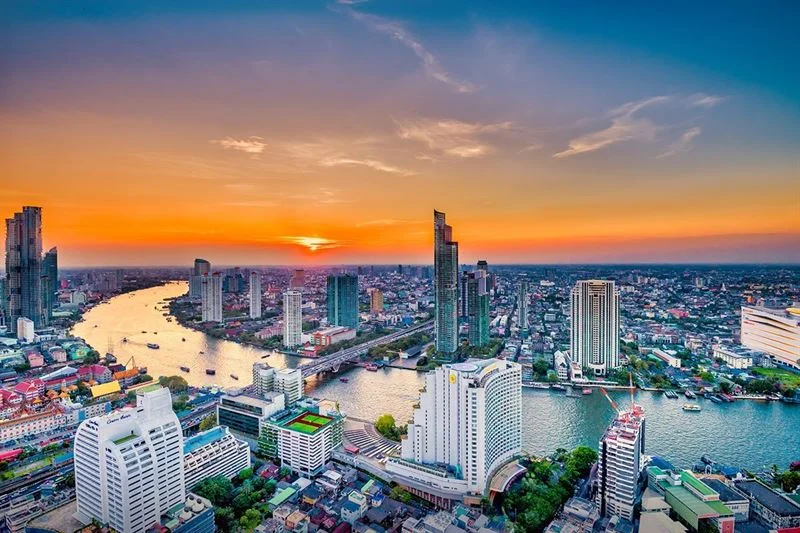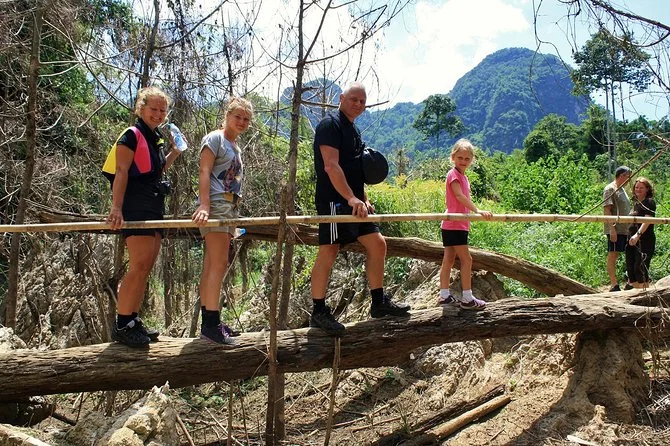Thailand Tour Packages
Thailand Honeymoon Tour Packages
Thailand Paradise Tour Package
Bangkok Phuket Krabi Tour Packages
Thailand Best Seller Tour Package
Thailand in Monsoon: A Rain-Soaked Paradise of Tranquility and Adventure
Thailand in monsoon season (June to October) offers a unique and refreshing travel experience. While many travelers associate the rain with limitations, the season transforms the country into a lush green paradise. The downpours are usually short but intense, leaving plenty of time for exploration and activities. Fewer crowds during this period mean a more serene experience at popular attractions, and it’s also the perfect opportunity to enjoy off-season discounts on accommodations and tours. The countryside, particularly in northern regions like Chiang Mai and Pai, becomes a vibrant spectacle of greenery, while waterfalls like Erawan and Thi Lo Su swell to their most majestic. For beach lovers, the Gulf Coast, including Koh Samui and Koh Phangan, remains relatively dry and welcoming. Thailand’s monsoon is a season of rejuvenation, offering tranquil beauty and the chance to explore a different side of this tropical destination.
Book here our Thailand tour packages.
Pros and Cons of Visiting Thailand in Monsoon
1. Pros:
1. Lower Costs: Cheaper flights and accommodations make it a great time for budget travelers. Popular attractions are less crowded, providing a quieter, more relaxed experience.
2. Lush Green Scenery: The monsoon rains transform the landscape into a lush, vibrant paradise. Regions like Chiang Mai and national parks are especially breathtaking during this time.
3. Unique Experiences: Cultural festivals like Khao Phansa add a unique touch to the season. The rains also bring cooler temperatures, making outdoor exploration more comfortable.
4. Adventure Opportunities: Full rivers and waterfalls make activities like white-water rafting exciting. Adventure destinations like Chiang Mai become even more thrilling.
2. Cons:
1. Unpredictable Weather: Rain showers can disrupt outdoor activities and travel schedules. Some areas might experience prolonged downpours or storms.
2. Limited Beach Activities: Rough seas and high waves make swimming and water sports unsafe. Boat tours and ferry services are often canceled due to bad weather.
3. Flooding: Heavy rains can lead to flooding, particularly in urban areas like Bangkok. This can cause travel delays and affect your overall plans.
4. Transportation Challenges: Poor road conditions in rural areas can make travel difficult. Train and bus schedules are also more prone to delays during this season.
Weather Conditions of Thailand in Monsoon
Monsoon season in Thailand falls during May and up to October, during which time different parts of the country can expect extreme changes in the weather. Heavy downpours are expected most days, especially in central and northern regions, raising humidity and lowering temperatures. Strong winds and stormy seas may be prevalent near the coast, whereas thick mist and clouds shroud the northern mountains. Although frequent downfalls cause temporary flooding, it rejuvenates the lush lands and is an essential feature for agriculture. Travelers should be prepared for storms that can come at any time and schedule their plans according to the unpredictable weather patterns of Thailand, which may give a very different view of the nature of the country.
Top Places to Visit in Thailand in Monsoon
1. Koh Samui

Koh Samui is one of the driest places in Thailand in monsoon, making it a top choice for travelers seeking sunny days amidst the rainy season. The island offers stunning beaches like Chaweng and Lamai, which are perfect for relaxation or water sports. Visitors can explore the famous Big Buddha statue, picturesque Na Muang Waterfalls, and charming fishing villages. Koh Samui also boasts a vibrant nightlife, particularly at the bars and clubs in Chaweng. For wellness enthusiasts, the island is home to numerous spas and yoga retreats. It’s a versatile destination that balances natural beauty with modern amenities.
2. Chiang Mai

Chiang Mai in northern Thailand transforms into a lush green paradise during the monsoon, with cooler weather perfect for outdoor exploration. The city is famous for its rich cultural heritage, with over 300 temples, including the iconic Wat Phra That Doi Suthep. Monsoon rains also enhance the surrounding landscapes, making nearby attractions like Doi Inthanon National Park and Mae Sa Waterfall even more spectacular. Adventure seekers can enjoy trekking, rafting, and ziplining through the rain-soaked forests. The city’s night markets and local cooking classes provide cozy indoor activities during rain showers. Chiang Mai is a harmonious blend of nature, adventure, and culture.
3. Bangkok

Bangkok remains a vibrant and bustling hub even during the monsoon season, with rain showers typically short and intense. The city offers countless indoor attractions, including luxurious malls, museums, and cultural landmarks like the Grand Palace and Wat Arun. Visitors can enjoy the bustling street food scene, with covered markets such as Chatuchak Market providing a great rainy-day activity. Bangkok’s nightlife is as lively as ever, with rooftop bars offering stunning city views, even during rain spells. The Chao Phraya River is especially scenic during the monsoon, with boat rides providing a unique perspective of the city. Bangkok is ideal for urban explorers who enjoy a mix of tradition and modernity.
4. Khao Sok National Park

Khao Sok National Park becomes a tropical paradise during the monsoon, with lush rainforests, flowing rivers, and towering limestone cliffs at their most dramatic. The season brings life to waterfalls and enhances the beauty of Cheow Lan Lake, perfect for kayaking or boat tours. Visitors can stay in unique floating bungalows on the lake, offering a peaceful escape into nature. Jungle trekking is an unforgettable experience, with the opportunity to spot diverse wildlife, including gibbons and hornbills. The park’s biodiversity and serene atmosphere make it a must-visit for nature lovers. Despite the rains, activities here are immersive and rewarding.
5. Hua Hin

The coastal town of Hua Hin is not far from Bangkok, so the monsoon rain here is quite gentle. Long sandy beaches make this a perfect destination for a leisurely walk or a peaceful day of solitude. It’s also home to some of the world’s finest vineyards with wine tasting and beautiful views. Night markets here feature delicious street food and quirky shopping experiences. There is also the royal summer palace, Maruekhathaiyawan Palace, which presents beautiful Thai architecture and history. Hua Hin is a relaxed destination, perfect for travelers seeking a mix of beach vibes and cultural charm.
What to pack for the Monsoon trip to Thailand?
1. Clothing: Pack lightweight, breathable clothes made of cotton or moisture-wicking materials to stay cool in the humid weather. Include a waterproof jacket or poncho for sudden downpours and comfortable shoes for walking in wet conditions.
2. Rain Gear: A compact umbrella is essential for unexpected rains, while a waterproof backpack or cover will protect your belongings. These will keep you dry and your items safe from getting soaked.
3. Accessories: Mosquito repellent with DEET is necessary due to the increased number of mosquitoes during the rainy season. Bring sunscreen for sun protection and a hat to shield your face from both rain and UV rays.
4. Gadgets: A waterproof phone case is crucial to protect your electronics from rain, and a power bank ensures your devices stay charged during long days out. Don’t forget a travel adapter for Thailand’s electrical outlets.
5. Toiletries: Pack a quick-dry towel for unexpected rain or outdoor activities and anti-humidity hair products to manage frizz in the damp air. Bring a basic first aid kit with medicines for common ailments and insect bites.
6. Travel Essentials: Use plastic or ziplock bags to protect your electronics and documents from rain. A light scarf or shawl is versatile, serving as rain protection or a cover-up at religious sites.
7. Optional Items: Consider bringing dry bags to keep valuable items like cameras completely dry during adventures. Trekking poles can help hike on slippery or muddy trails during the rainy season.
Tips for traveling to Thailand in Monsoon
1. Check Weather Forecasts Regularly: Before and during your trip, keep an eye on the weather forecasts to help plan your activities. This will help you avoid getting caught in intense downpours.
2. Pack Appropriately: Bring lightweight, quick-drying clothing and a waterproof jacket or poncho. Don’t forget comfortable walking shoes that can withstand wet conditions.
3. Plan for Indoor Activities: Have a list of indoor attractions or activities in case of heavy rain. Museums, shopping malls, and cultural sites are great options to enjoy on rainy days.
4. Be Flexible with Your Itinerary: Since the weather can be unpredictable, it’s important to remain flexible. Be ready to swap outdoor plans for indoor ones if necessary.
5. Stay Hydrated: The humidity can be high during the monsoon season, so remember to drink plenty of water, even if it’s overcast.
6. Consider Transportation Options: Research transportation methods ahead of time. Flooding can affect roads and public transport, so knowing your alternatives can save you time and hassle.
7. Travel Insurance: Invest in travel insurance that covers weather-related disruptions. This provides peace of mind in case your plans change suddenly.
8. Explore Off-the-Beaten-Path Destinations: With fewer tourists around, consider visiting less popular destinations that may offer unique experiences without the crowds.
Conclusion
In conclusion, Thailand in Monsoon presents the perfect opportunity to feel this country in a different quieter, more serene sense. Although the weather will always be unpredictable, landscapes covered in lush green, very low prices, and with fewer crowds, make the place a great atmosphere for adventurous travelers. All of these major destinations like Koh Samui, Chiang Mai, and Krabi are full of attractions, especially when the rains begin and natural beauty is increased. So you’ll still have the ability to enjoy all that Thai culture, stunning scenery, and vibrant local life in your travels with the right preparation and flexibility. In addition, the monsoon season has its rewards, allowing a memorable and authentic experience while traveling.
Here you can also check our Thailand tour packages.
People also ask about Thailand in Monsoon
1. When is the monsoon season in Thailand?
The monsoon season in Thailand typically runs from May to October, with the heaviest rainfall usually occurring in August and September.
2. Is it a good time to visit Thailand in monsoon?
Yes, the monsoon season offers lower prices, fewer crowds, and lush landscapes, making it an excellent time for budget travelers and those seeking a quieter experience. However, the weather can be unpredictable, so flexibility is key.
3. What are the weather conditions like during the monsoon?
Expect warm temperatures ranging from 25°C to 33°C (77°F to 91°F), high humidity, and frequent rain showers, often in the late afternoon or evening. Some areas, especially in the north, may experience cooler conditions, while southern islands like Koh Samui receive less rainfall.
4. Which places are best to visit during the monsoon?
Destinations like Koh Samui, Chiang Mai, Pai, and Hua Hin are popular during the monsoon season. These areas experience milder rains and offer plenty of activities despite the weather.
5. Should I be concerned about flooding during the monsoon?
Flooding can occur in some areas, particularly in cities like Bangkok during heavy rains. While it’s not common everywhere, it’s important to stay informed and plan accordingly, especially if traveling to more flood-prone regions.
6. What activities can I do during the monsoon season?
While beach activities may be limited due to rough seas, you can enjoy cultural attractions, indoor activities, and nature-based experiences like hiking, exploring waterfalls, or visiting temples. Adventure seekers can also go rafting or ziplining in areas like Chiang Mai and Khao Sok National Park.
